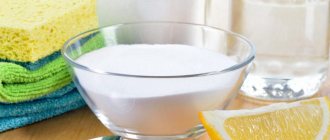A side effect of renovating an apartment or house using paints and varnishes is a persistent smell from the paint.
It should be gotten rid of as quickly as possible, not only because of the discomfort it causes, but also because of the harm to the health of residents.
Professional advice in combination with various folk remedies that are always at hand will help with this. In this article, we will look in detail at how to remove the smell of paint in an apartment after renovation quickly and easily.
Types of intoxication
There are two types of conditions:
- Acute poisoning with paint fumes. Most often it occurs during the season when home construction work begins. The main trigger is a gross violation of safety regulations.
- Chronic. The insidiousness of this condition is that the symptoms manifest themselves over time. Most often observed among professional painters who deal with paint fumes every day.
When working with paints and varnishes, you should strictly follow safety rules, for example, use a mask. It should fit snugly to the nose and provide reliable protection for the mouth.
As soon as during work you notice an unpleasant odor coming from your mouth and the sensations in your nose begin to bother you, you should stop painting and leave the room.
In addition to a respirator, gloves and goggles should be used.
Protective measures also include choosing safe paint. For a children's room, for example, you should choose water-based materials. Walls and ceilings can be painted with acrylic paint. This can also be done in rooms where allergy sufferers live. In children's rooms, it is allowed to use material that has a photocatalytic effect - specially selected components of natural origin react with light, make the air free of volatile organic substances, disinfect it, destroy bacteria and odors.
If you plan to paint children's furniture, the recommendation to use water-based paints or acrylic paint remains relevant.
After renovation
Only after a thorough cleaning of the workplace and all rooms where repairs were carried out can the curtains be removed from the doors and windows. When cleaning, frequently change the water in which you rinse the cloth or mop. By the way, the easiest way to wash off construction dust is with a mop that is equipped with a sponge. Expect that you will need several replacement mop heads, and sponges and rags will quickly become unusable.
A serious construction vacuum cleaner will be an excellent assistant during and after repairs. If necessary, it can be rented.
The nuances of cleaning after renovation
- The main task when mopping the floor is to collect dust, so you should not rub it hard on the floor, but collect dust with simple movements of the mop from afar towards you. After several passes with the mop, wash it thoroughly. At this stage, areas where the mortar or glue has stuck and dried will be clearly visible and cannot be removed with a mop. If they are on a protective film, then you shouldn’t do anything with them. If they are on the base of the floor or on other finishing surfaces, then carefully use a spatula to pry them up and remove them. In some cases, it is advisable to use a rubber spatula or wooden spatula.
- After the bulk of the dirt has been removed and all the bulky debris has been taken out, you can go through all the corners and crevices with a vacuum cleaner. A flat nozzle with an end cut off at an angle is used. After this, wipe absolutely all vertical surfaces and horizontal ones at height with a damp cloth.
- All protective films are carefully removed; you can first moisten them from the sprayer. Once everything is unpacked and the film has been removed from the apartment, you can begin the final stage of cleaning. The entire surface is cleaned with damp rags and sponges. It is unlikely that you will be able to get rid of all the stains at once. You will have to thoroughly clean the entire surface several times over the course of several days, after which only the apartment will sparkle with cleanliness.
vote
Article rating
| 22-01-2019 19:19 |
Research work: “The influence of paints on the human body”
Harmful substances contained in paints and varnishes can affect the human body through the respiratory tract, skin and digestive tract. Together with the air, vapors of solvents and an aerosol containing both solid particles and the liquid component of the paint enter the human lungs through the respiratory tract. At the same time, harmful substances that enter the body through the respiratory tract have a greater negative impact than when entering through the gastrointestinal tract, since in this case they enter the blood faster.
Paints and varnishes, like all chemical products, should be stored out of the reach of children. Even an aerosol can is dangerous in the hands of a child.
People with many years of experience in apartment renovation know that the smell of paint and varnish products is persistent and eats into surfaces and fabrics. The rooms where painting will be carried out should be completely cleared of furniture and other things. Choose water-based paint; it gives a high-quality coating and is practically odorless.
A special paint is produced for heating elements that does not emit toxic fumes when heated. While working, you should use a respirator, wear gloves to protect your hands, an old T-shirt and jeans that you don’t mind getting damaged by drops of paint. It is worth periodically ventilating the work area, tightly closing the jars with the substance, and cleaning used brushes and rollers with a special solvent outside.
Ventilation
Through ventilation during the day is a simple and effective method, but is suitable for use only in the warm season. In winter, you cannot open the windows for a long time, the rooms will become cold, and the paint will take longer to dry. You need to open windows and doors, and you can turn on several fans to speed up air circulation. The method allows you to remove the unpleasant odor in one day.
Wet sheets
Hanging wet sheets or towels will help remove lingering odors; the evaporating liquid will absorb paint molecules floating in the air. As it dries, you should thoroughly rinse the fabric you are using, wet it and hang it until the chemical odor is completely eliminated.
Buckets of water
An alternative to hanging wet fabric is wide and deep containers of cold water placed around the entire perimeter of the room. By intensively humidifying and opening windows to allow fresh air flow, pungent fumes will quickly dissipate.
Conditioning
An air conditioner with a special “air purification” function or with an ionization program will help remove the smell of paint in the apartment. A modern device sucks in contaminated air, passes it through built-in filters, removing any remaining paint fumes. Then he releases it back, clean and fresh.
To quickly get rid of the suffocating odor, you can use several methods, including the use of folk remedies.
To eliminate the stench from chemical dyes, simple substances and objects that can easily be found at home are suitable.
The pleasant smell of freshly brewed coffee can overpower the amber of paint and varnish products. To enhance the effect, you can place coffee beans or grounds from a drink in the room; as it is absorbed, it is worth updating the natural sorbent.
Ammonia
After the painted surfaces have dried, it is necessary to carry out wet cleaning. In 2 l. 10 ml of cool water should be added. ammonia and vinegar, then wipe the room with the prepared solution, including walls and radiators. After treatment, the room should be thoroughly ventilated.
Aroma oils
The use of essential oils helps remove toxic fumes from the home after renovations. You can place containers of water in the rooms and add a few drops of lavender or mint oil. A good effect is achieved by using a moisturizer with the addition of concentrated herbal extracts. You can remove volatile vapors using an oil lamp; they will disappear along with the fragrant smoke.
Activated or picnic charcoal are considered an accessible sorbent that perfectly absorbs toxic fumes. The product used should be placed in an enamel container and placed indoors. Change the coal several times until the evaporation is completely eliminated.
Onion and garlic
When these vegetables are cut, special substances, phytoncides, are released. Their strong aroma can protect against pathogenic bacteria floating in the air and hide the smell of paint. Chopped onions and garlic are laid out in flat plates that need to be placed in the rooms. After a few hours, the room needs to be ventilated.
Bright and juicy fruits smell pleasant, which is important after repairs. The lemon should be cut into slices and placed around the perimeter of the room, and as it dries, prepare fresh slices again. To obtain a long-lasting effect, you can spread citrus peels on heating devices.
This method involves applying baking soda to the carpet, upholstered furniture or clothing to remove stubborn odors. Apply the powder and leave for 24 hours; after the procedure, you need to thoroughly vacuum the carpet or sofa, and shake your clothes to remove any residue.
Wax candles will cope with the residual odor from paints and varnishes; the remaining volatile vapors are burned in an open fire. When using this method, you should strictly follow fire safety precautions, keep the doors to the room open and do not leave lit candles unattended.
If there is a high concentration of toxic substances in the room, you should turn to professional air purification methods.
How can I prevent or reduce intensity in the future?
To avoid a strong spread of paint aroma upon completion of repairs, it is worth taking certain protective measures in advance.
This means the following actions:
When choosing paints and varnishes, preference is given to water-based ones, as they smell less.- A few drops of vanilla essence are mixed into the paint, but a compatibility test is first carried out (mix in a small amount).
- Immediately after completing the painting work, close the jar tightly and wrap it with plastic wrap.
- The brushes are cleaned in the fresh air and immediately soaked in water.
- Painting and painting operations are carried out with the windows open and the fan running, which will minimize harm to the body.
If possible, before starting repairs, remove upholstered furniture, textiles and anything that easily absorbs foreign odors from the room. If this cannot be done, then cover the entire situation with film.
Symptoms of poisoning
It is possible to take adequate measures only if the main symptoms of poisoning are known. They are usually divided into two groups – primary and secondary.
Primary symptoms include:
- painful attacks of nausea accompanied by vomiting;
- the victim often has a headache for a long period of time;
- profuse lacrimation, accompanied by redness and burning;
- dizziness, loss of consciousness;
- stomach upset;
- pallor, discoloration of the skin surface (especially near the mouth);
- the smell of acetone coming from the mouth;
- shallow, heavy breathing.
Secondary symptoms include:
- disorders of the respiratory system due to lack of oxygen (dry mouth and nose);
- ophthalmological pathologies that can cause vision loss;
- changes in the functioning of the cardiovascular system.
With chronic intoxication, complaints look similar:
- constant fatigue, apathy, decreased mental activity;
- persistent dry cough;
- unpleasant sensations in the nose, eyes;
- sleep disturbance;
- nausea, loss of appetite;
- complaints of a headache in the back of the head.
These symptoms also cannot be ignored by doctors.
Radical campaign
If none of the above has brought adequate relief, and residents are bothered by an intrusive smell, have difficulty breathing in the rooms, and allergies often appear, this is a signal for radical remedies.
Perhaps the reason is furniture made from cheap chipboard, which is saturated with harmful formaldehyde. If the concentration of hazardous substances is too high, it takes too long for the chemicals to erode. The solution is to replace the problematic furniture. If possible, it is better to replace it with simple functional options made of pine, which is not only durable, but also has a beneficial effect on the air in the room.
Another source of persistent odor is various coatings. It is worth assessing the materials and quality of the coating on the ceiling, walls, and floor. The problem may be in the material with which they are covered, or in the paints and varnishes applied to them. This cannot be done without rework, and you will have to be especially picky when choosing new products.
If it is difficult for apartment owners to determine the cause of a persistent chemical odor after renovation, you can use the services of an expert who will find out the source of the unwanted odors and give recommendations on how to solve the problem.
The plan for dealing with chemical odors after renovation is simple. Airing starts first, then you can start with home remedies like wet rags and odor-absorbing products, or switch to fragrances and incense. Also, do not forget about professionals who can find the source of the odor and eliminate it in a short time.
Get rid of the smell after renovation in an apartment or office. How to quickly remove the sour smell of plaster, putty, remove the acrid smell of paint. We effectively eliminate unpleasant odors in any premises in Moscow and the Moscow region.
The smell of paint after renovation brings back memories of September 1, when a freshly painted school greets students. However, romantic memories of school years end as soon as you have to deal with a strong and pungent smell in real life. In your apartment, at your workplace in the office. Headache and nausea are a standard set of symptoms of poisoning. How to get rid of the smell after renovation? How long does it last? We will figure it out together with you.
What does the apartment smell like after renovation?
Half of the periodic table is floating in the air after a major overhaul. In new buildings, after finishing, literally everything emits a smell:
- wall materials - concrete, putty, primer, insulation, drywall;
- finishing materials - paint, plaster, wallpaper (non-woven, vinyl);
- flooring materials - linoleum, carpet, laminate (especially underlays);
- stretch ceiling;
- plastic windows;
- lamps and chandeliers (base, wiring, lamps);
- furniture made of MDF, chipboard.
Chemical aromas are especially noticeable in the first months after completion of work. It's not just an unpleasant smell that makes your head foggy. This is a truly dangerous mix of toxic substances. If you do not purposefully remove the smell, after repair, at best, you will have to breathe for 3-6 months:
- phenol
- ammonia
- formaldehyde
- styrene
- vinyl chlorides.
All these substances have carcinogenic, mutagenic and allergenic properties. A toxic cocktail depresses all body systems and can cause serious problems. Odor removal after renovation reduces the level of hazardous compounds, providing a pleasant aroma and a healthy environment in which to live and work.
Why is there an unpleasant smell in the room after renovation?
The question naturally arises: how do such dangerous building materials get into our apartments?
They fake everything: from mixtures to linoleum and roller blinds. A label with a well-known brand is printed on a cheap analogue and sold slightly cheaper than the original. And who would refuse a freebie? Developers benefit greatly from such purchases. However, no one is safe from fakes.
Expired putty, for example, smells sour. Many other consumables have limited expiration dates. Next time, be sure to look at the release date of the purchased building materials.
Bitumen indoors? - Please! OSB board - as much as you like! And then, with the windows closed, the smell from the renovation is terrible. It can only be removed from the room together with the source of the stench itself.
We are talking about those materials that dry faster, retain plasticity longer, etc. To give traditional materials new qualities, they use chemicals that can smell pungent.
The standard approach of domestic and foreign builders: make it look beautiful, but don’t think about ventilation. With PVC ceilings and plastic windows, linoleum on the floor and non-woven fabric on the walls, the room becomes airtight. Poor air exchange leads to increased humidity, and this, in turn, leads to the formation of mold on the walls. And mold increases the smell after renovation.
Haste is a momentary benefit. In practice, hasty repairs can lead to delays in drying/curing of materials. For example, wallpaper glued over damp plaster leads to the formation of mold.
How to get rid of the smell after renovation?
If you are not tolerant of chemical smells and care about your health. Also, commercial facilities - restaurants, hotels, offices - here an unpleasant, pungent odor is not acceptable at all. How to create a pleasant, inviting atmosphere when everything around you stinks of paint? There is no expectation that guests will be satisfied with their dinner or relaxation in such conditions. The only sure way is to purposefully remove the smell immediately after the repair.
The dry fog deodorization service from the ProfEkoDez sanitary service for apartments, houses, cafes, restaurants, hotels and offices helps remove odors from paint, finishing panels, putty, plaster, new furniture and other strong-smelling building materials.
How to remove the smell after renovation?
To scent the room and neutralize unpleasant odors after renovation, special equipment is used - a dry fog fogger. An odor-eliminating liquid is added to it, and in a matter of minutes the room is filled with dry fog. The ProfEcoDez service uses the most effective and concentrated preparations. The fog itself is a fine fraction of a neutralizing substance. Due to the tiny particles of mist in the air, larger molecules of chemical aroma are not detected by the human sense of smell.
The most difficult situation is when you cannot determine what exactly it smells. A disinfection specialist always begins his work with an inspection of the apartment or premises. ProfEcoDez experts know what and where to “sniff” and can find the cause by smell. Our employees have hundreds of repairs and situations under their belts in which deodorization helped identify a problematic object and relieve residents of the smell after repairs.
Deodorization after renovation
Deodorization after repair has a positive effect - the fragrance will completely disappear from the object.
We would like to know what materials were used in the renovation. This will help the specialist choose the right neutralizer. For example, putty can be based on organic and chemical components. These are two different odor removers.
Dry fog does not produce sediment. Finishing, furniture fabrics - everything will remain in its original form, without marks or streaks.
After anti-odor treatment, be sure to ventilate the room with fresh air for at least 15 minutes. The first days the flavor will be felt more pronounced, then it will become barely perceptible.
Deodorization of premises from the ProfEkoDez company will help you easily get rid of the odors of building materials and new furniture and will improve the working environment in the office and create a favorable atmosphere in the apartment.
We use safe products made in the USA. Today they are the most effective and concentrated. The ProfEcoDez Sanitary and Epidemiological Station does not use cheap and ineffective Chinese or Russian drugs. That's why our company uses proven drugs.
Call and find out which scent will save you from the obsessive smell after renovation. Our room
Harm from cosmetics on the human body
— It also contains bronopol. This chemical is a derivative of formaldehyde. It is added to face creams and deodorants. Its concentration should not be higher than 1%. Otherwise, health problems may arise. It can often be found in the preparations of the Swedish company Oriflame, in Russian and Belarusian cosmetics. That's it... in pursuit of money, native producers are still in the same place.
Cosmetics for the face, body, arms and legs... how can you do without them? Every woman knows that proper nutrition, sports, daily skin care - all this is necessary to preserve youth and beauty and occupies an important place in the life of each of us. This is the way we are made, that we vitally need to like it.
Wet cleaning of painted surfaces
Wet cleaning of painted substrates helps to quickly get rid of odor. However, if you use plain water, the effect will be negligible.
The following additives are used to prepare aqueous solutions:
- Dry mustard. Add 1-2 tablespoons of the substance into a 10 liter bucket of warm water. Having crushed the liquid, wipe the painted bases with it (it is more convenient to do this with a sponge). As a rule, this option is used for processing wooden surfaces.
- Vinegar or ammonia. The concentration here is slightly less - 1 tbsp. l./5 l of cold water. The prepared solution can be used for wiping wood, metal and plastic substrates.
Special factors
The deterioration in health observed when working with paint is violated can easily be confused with such an equally common phenomenon as an allergy to the smell of paint.
If a person is unaware of his body’s nonspecific reaction to paint and varnish materials, he can easily confuse the first signs of an upcoming attack with paint poisoning. There may be discomfort in the nose, dizziness, pain in the eyes, lacrimation, and bad breath. With an allergy, some time after contact with the provoking factor, specific causes of poor health begin to appear, which distinguishes it from poisoning:
- itching, peeling;
- the appearance of skin rashes;
- My head hurts even more intensely.
In addition, even after stopping contact with the dye, you can still smell it in your nose. If you do not pay attention to this condition for a long time, it becomes chronic. The consequences can be extremely severe, including disability.
The occurrence of a severe allergic reaction requires immediate contact with a medical facility and adequate treatment.
During intrauterine development, the baby breathes oxygen supplied by the mother. The poisoned air she inhales passes through the circulatory system to the fetus, which increases the risk of defects in the genitourinary system and negatively affects the further quality of lung function. Therefore, pregnant women should refuse to participate in renovations (even of the future nursery), so that neither the expectant mother nor the child suffers from the influence of paint.
Silica gel filler
If there is a cat living in the house, use silica gel litter for its litter tray to remove the paint smell. This is a proven eliminater of odors and excess moisture, so in this case you can trust the professionals and not do anything yourself.
Just pour the granules into trays and leave them indoors. The filler does not need to be changed or updated - usually one fill is enough to combat paint odor.
Review of specialized odor eliminators
You can get rid of the unpleasant smell of paint in your home using absorbents:
- Available options include silica gel - granules for filling cat litter. This substance absorbs the very cause of the odor, purifying the air in the room.
- An expensive product is a sorbent for the refrigerator. It is made from a mineral called zeolite. Its main property is to remove the concentration of gaseous substances. Zeolite granules are packaged in small boxes, they should be opened and placed in a bad-smelling room for several days.
- An industrial ozonizer effectively purifies the air in an apartment. Ozone is a powerful oxidizing agent that destroys pathogens and toxic chemical elements.
During painting work, toxins from dyes are absorbed into the coating of walls, wooden partitions, and cabinets. These surfaces will gradually release harmful substances that can harm the body, they are especially harmful to a small child. After renovation, it is recommended to constantly ventilate the room and carry out regular general cleaning using natural cleaning products.
Smell of putty after renovation
Hello!
We just can’t get rid of the smell after renovating our apartment. The renovation was completed at the end of July 2022, the apartment stood with the windows open throughout August and September. Now we open the windows periodically. 6 months have passed, the smell has become less, but still, with the windows closed, it accumulates again from somewhere within a day. The smell is suffocating, chemical, not wood, not acetone, not rotten. The smell was present BEFORE the installation of interior doors and the delivery of furniture. The workers who did the repairs do not hear the smell or pretend that they do not hear it. There was no arguing with the workers. We don’t live in an apartment, as soon as you enter the apartment it immediately hits your nose. They tried to do the renovation environmentally friendly, using expensive materials, but alas. The ceiling is plastered, with a mesh to prevent cracks, puttied, painted with Tikkurila ceiling paint. On the walls there is Volma Plast, Vetonit putty, non-woven wallpaper, Tikkurila latex paint. Porcelain tiles with Ceresit glue, Ceresit grout. On the floor there is Ceresit self-leveling floor, noname cork backing, Kronotex laminate. If I need more precise names of materials, I will try to find out from the workers, although this is not easy.
They sniffed the whole apartment, there was no strong smell. Installing a humidifier did not help. They tore off a piece of laminate and put the backing in a sealed bag, there is a faint smell of wood, but it is not it.
Are there any methods for detecting odor? Maybe there are companies that specialize in this. The workers say that now everything smells, but not for 6 months. The Internet is full of complaints that the smell does not disappear for years! Thank you
A couple of weeks ago, Vetonit putty was applied to the walls in the house, but the terrible smell is still there. What to do if there is a smell of Vetonit putty and the smell does not dissipate?
Vetonite has a slight odor and usually disappears completely after a couple of days with good ventilation.
The reason that the smell is “horrible” and does not disappear for a long time may be that the putty did not dry for a long time - it was applied to damp walls, in a damp room, applied in a thick layer in one pass.
At one of our facilities we had a similar situation with an unpleasant odor. The putty was already dry, but the smell did not dissipate. A deep penetration primer in two layers did not help either.
Friends from a cleaning company helped and advised us to treat the putty walls with Zinsser primer. Surfaces after fires are impregnated with it and it blocks burning odors well. After one treatment the smell disappeared completely.
You can try this method, but make sure that the putty is completely dry - dig a hole somewhere in an inconspicuous place. Dry should fall out .
Most likely we are talking about the finishing putty “Vetonit KR”,
Yes, this putty has a peculiar smell.
If you follow the technology for preparing and applying the putty, the smell will disappear over time, unless of course Vetonit is the wrong one.
There is a limit on the thickness of this putty, 4 mm; if the layer is thicker, it will take longer to dry.
This is the first “what to do”: let the putty dry completely.
If there is a dry layer under the putty, for example starting putty, then Vetonit will simply dry and the smell will go away.
In any case, you have to wait, more or less time, but wait (to dry the surface, perhaps the humidity in the room and temperature are not appropriate, it will take a long time to dry).
If you are sure that the putty has completely dried, then there is a second option for the smell, the finishing putty prepares the walls for painting (as an option) paint the surface with **vapor-proof* * paint, it will “lock out” the smell of “Vetonit”.
This is the main thing, but I think the reason is a violation of technology and preparation and application.
Apartment renovation is an unusual event. Therefore, you need to approach it with all responsibility. And the point is not only in finding responsible craftsmen, but also in choosing materials for repairs: paints, varnishes, putty, wallpaper, etc. Otherwise, an unpleasant odor after plastering walls or ceilings may turn out to be an unexpected “surprise”. What to do to avoid chemical smell after renovation? How to solve the problem if the terrible smell after putty literally prevents you from staying in the apartment? Find answers to these questions in our article.
Why is zinc production harmful to the human body?
Few people know, but it turns out that the effect of vitamin A largely depends on whether there is enough zinc in the body, since it activates the work of the vitamin and organizes its movement through the blood vessels to every cell of the body. Foods containing zinc: pay attention to seafood Large amounts of zinc are found in the pituitary gland (the main endocrine gland in our body), other endocrine glands, liver, skeleton, nails and hair.
We recommend reading: Waybill for the Director on a Company Car
Is zinc harmful? Professor Jay von Fraunhofer led a study examining the beneficial effects of zinc on the body. But is zinc harmful? As a result of experiments, it turned out that this chemical element also has an extremely negative effect on humans.
Coffee beans
Coffee is a well-known natural sorbent that not only absorbs foreign odors, but also has a pleasant invigorating aroma.
To work, take any cheap natural (preferably grain) coffee, grind it and sprinkle it on trays, plates or any other flat surface in a thin layer. Place in a problem area, close the door, wait 16-20 hours (can be left overnight). During this time, the coffee should not just absorb the paint, but disguise it.
Important! After cleaning, the coffee must be thrown away; drinking it is harmful to health.
First aid and treatment measures
In case of poisoning by paints and varnishes, first aid should be provided as soon as possible. General procedure:
- Take the victim outside.
- Providing alkaline drinks (milk with soda or water with sugar and soda) in large quantities is the best treatment until doctors arrive.
- If there is a loss of consciousness, the poisoned person is placed on his side, his head should lie freely, one leg should be bent at the knee to avoid falling over. To bring the victim to consciousness, a cotton swab moistened with ammonia is brought to the nose.
Indirect cardiac massage and other resuscitation measures, if the necessary skills are available, can be performed not only by a medical professional. Treatment of poisoning is carried out in the toxicology department of the hospital.
Using an open flame
Volatile toxic substances are neutralized by direct contact with open fire. If possible, turn on a gas burner in the room for a short time (like those used when installing PVC stretch ceilings). It is clear that such a radical method will not work everywhere.
You can also use regular candles, evenly placing them on safe stands. Such cleaning may only be carried out under constant supervision. A safer option is to “work out” the room with a simple “wind blower” heater. The air in such devices is forced through a hot metal sieve, where the toxins will “burn off.”











